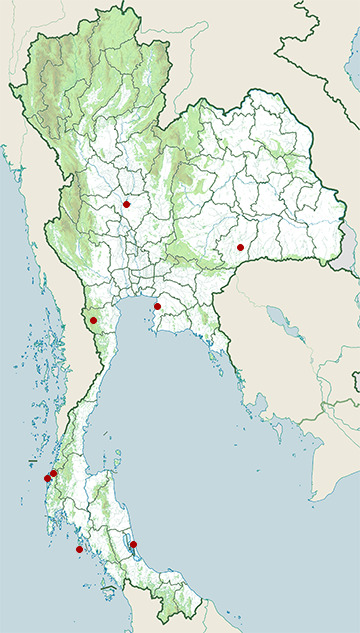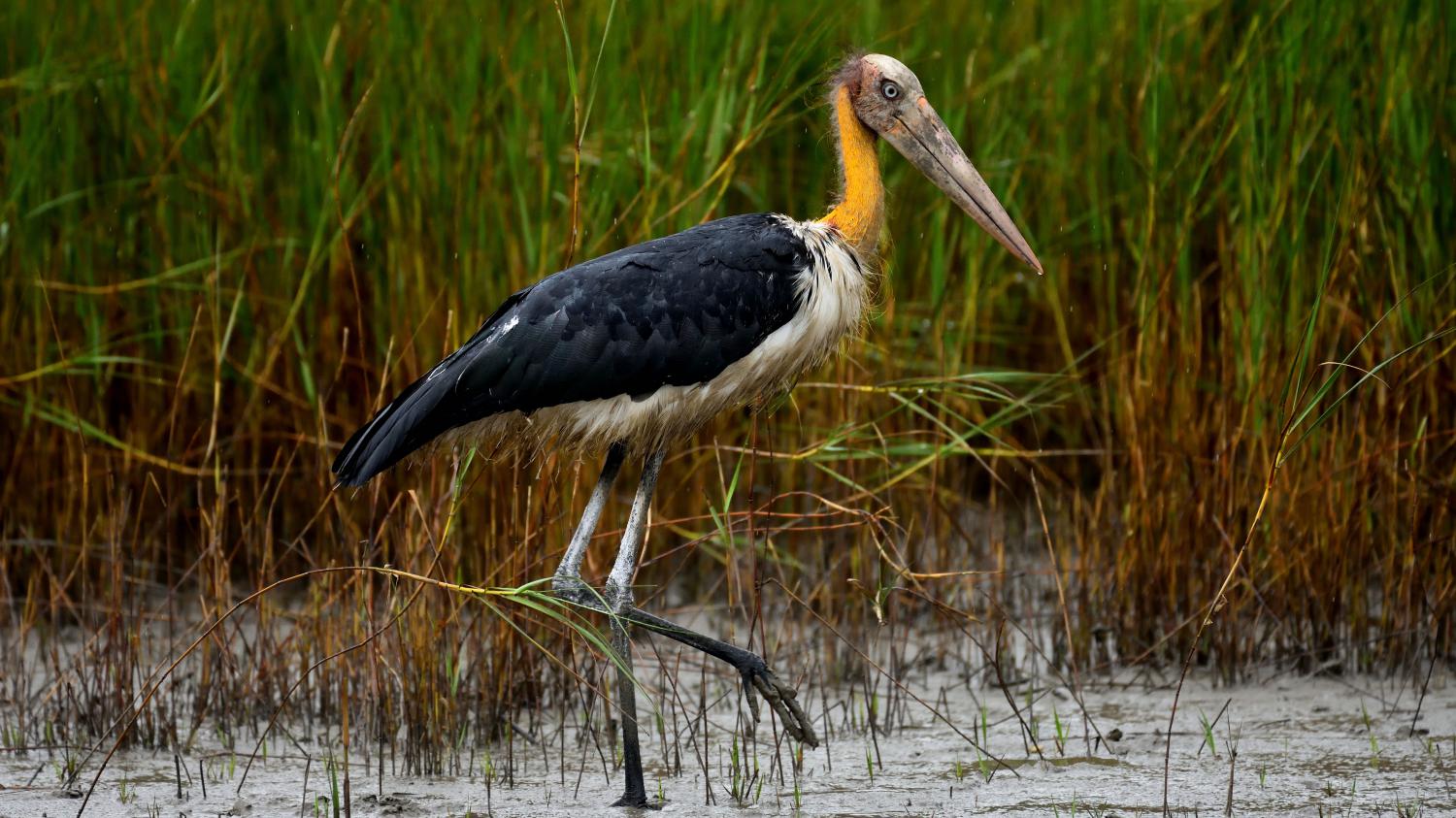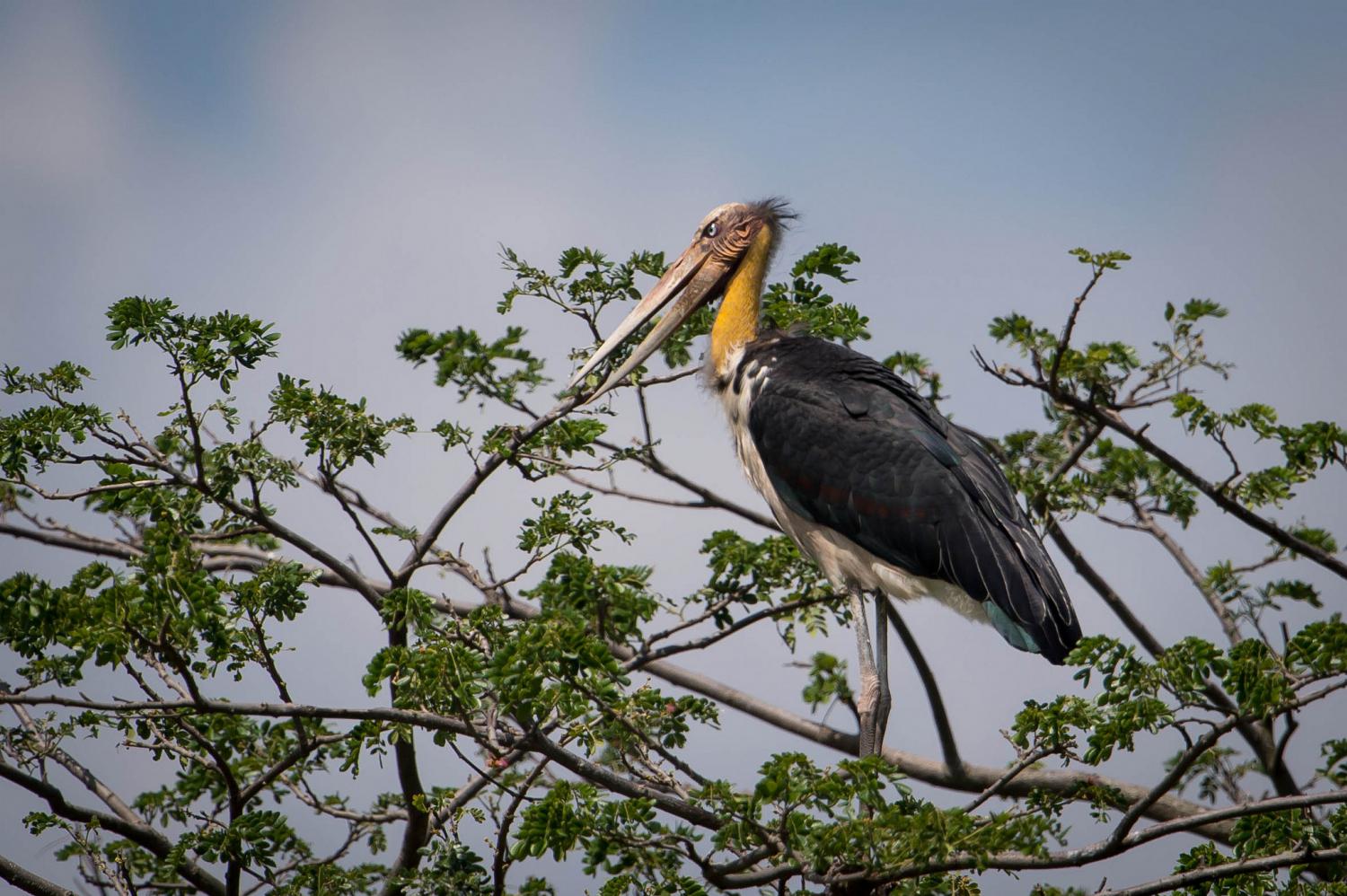Species of Thailand
Lesser adjutant
Leptoptilos javanicus
Thomas Horsfield, 1821
In Thai: นกตะกรุม
The lesser adjutant (Leptoptilos javanicus) is a large wading bird in the stork family Ciconiidae. Like other members of its genus, it has a bare neck and head. It is however more closely associated with wetland habitats where it is solitary and is less likely to scavenge than the related greater adjutant. It is a widespread species found from India through Southeast Asia to Java.
Description
A large stork with an upright stance, a bare head and neck without a pendant pouch, it has a length of 87 – 93 cm (outstretched from bill-to-tail measurement), weighs from 4 to 5.71 kg and stands about 110 – 120 cm tall. The only confusable species is the greater adjutant, but this species is generally smaller and has a straight upper bill edge (culmen), measuring 25.8 - 30.8 cm in length, with a paler base and appears slightly trimmer and less hunch-backed. The skullcap is paler and the upper plumage is uniformly dark, appearing almost all black. The nearly naked head and neck have a few scattered hair-like feathers. The upper shank or tibia is grey rather than pink, the tarsus measures 22.5 - 26.8 cm. The belly and undertail are white. Juveniles are a duller version of the adult but have more feathers on the nape. During the breeding season, the face is reddish and the neck is orange. The larger median wing coverts are tipped with copper spots and the inner secondary coverts and tertials have narrow white edging. The wing chord measures 57.5 - 66 cm in length. Like others in the genus, they retract their necks in flight. In flight, the folded neck can appear like the pouch of the greater adjutant. Males and females appear similar in plumage but males tend to be larger and heavier billed.
Distribution and habitat
The lesser adjutant tends to be widely dispersed and is very local. It is often found in large rivers and lakes inside well wooded regions. It is found in India, Nepal, Sri Lanka, Bangladesh (A colony with about 6 nests and 20 individuals was discovered near Thakurgaon in 2011.), Myanmar, Thailand, Vietnam, Malaysia, Laos, Singapore, Indonesia and Cambodia. The largest population is in India in the eastern states of Assam, West Bengal and Bihar. It may occur as a vagrant on the southern edge of Bhutan. They are extremely rare in southern India.
Behaviour and ecology
The lesser adjutant stalks around wetlands feeding mainly on fish, frogs, reptiles and large invertebrates. They rarely feed on carrion. They may also take small birds and rodents particularly during the breeding season. They are solitary except during the breeding season when they form loose colonies. The breeding season is February to May in southern India and November to January in north-eastern India. The nest is a large platform of sticks placed on a tall tree. The nest diameter is more than a metre and up to a metre deep. The clutch consists of three to four eggs. They are silent but have been noted to clatter their bill, hiss and moan at the nest.
This article uses material from Wikipedia released under the Creative Commons Attribution-Share-Alike Licence 3.0. Eventual photos shown in this page may or may not be from Wikipedia, please see the license details for photos in photo by-lines.
Category / Seasonal Status
Wiki listed status (concerning Thai population): Rare
BCST Category: Recorded in an apparently wild state within the last 50 years
BCST Seasonal status: Resident or presumed resident
Scientific classification
- Kingdom
- Animalia
- Phylum
- Chordata
- Class
- Aves
- Order
- Ciconiiformes
- Family
- Ciconiidae
- Genus
- Leptoptilos
- Species
- Leptoptilos javanicus
Common names
- Thai: นกตะกรุม
Conservation status

Vulnerable (IUCN3.1)

Vulnerable (BirdLife)

Critically Endangered (ONEP)

Critically Endangered (BCST)
Photos
Please help us review the bird photos if wrong ones are used. We can be reached via our contact us page.
Range Map

- Bang Phra Non-Hunting Area
- Bueng Boraped Non-Hunting Area
- Kaeng Krachan National Park
- Khura Buri District, Phang Nga
- Ko Lanta National Park
- Ko Phra Thong
- Sanam Bin Reservoir Non-Hunting Area
- Sathing Phra District, Songkhla






